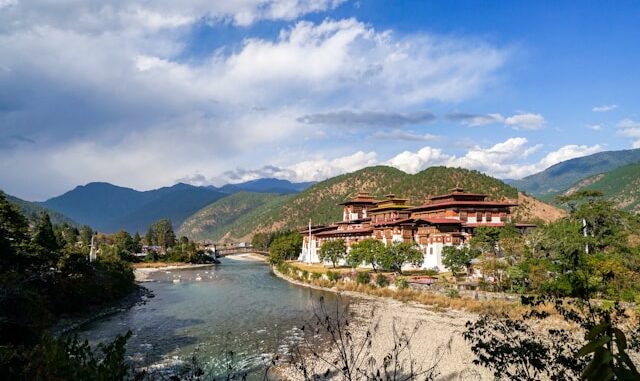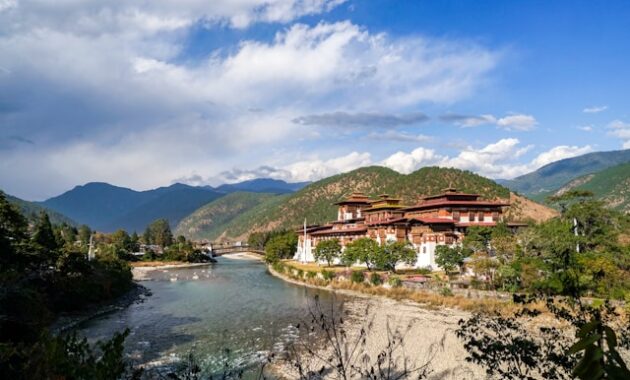
Nestled in the eastern Himalayas, Bhutan is a kingdom revered not only for its stunning natural beauty and Gross National Happiness but also for its deeply spiritual roots. Scattered across its rugged terrain are some of the most awe-inspiring temples and monasteries in the world. Each sacred site embodies centuries of history, mysticism, and architectural brilliance. In this guide, we explore Paro Taktsang and the top 7 temples in Bhutan that offer profound spiritual experiences beyond just their visual magnificence.
1. Paro Taktsang (Tiger’s Nest Monastery): Bhutan’s Spiritual Icon
No list of Bhutanese temples can begin without Paro Taktsang, also known as the Tiger’s Nest Monastery. Perched dramatically on a cliffside 3,000 feet above the Paro Valley, this sacred site is believed to be where Guru Padmasambhava meditated in the 8th century after flying to the location on the back of a tigress.
The hike to Taktsang Monastery is a spiritual journey in itself—winding trails, fluttering prayer flags, and dense pine forests lead to this architectural wonder. Inside, visitors find elaborate wall paintings, sacred relics, and a serene atmosphere steeped in centuries of devotion. Every step here is a connection with Bhutan’s living Buddhist heritage.
2. Kyichu Lhakhang: The Timeless Jewel of Paro
Located in the Paro Valley, Kyichu Lhakhang is one of Bhutan’s oldest and most revered temples, originally constructed in the 7th century by the Tibetan King Songtsen Gampo. According to legend, it was built to subdue a demoness whose body stretched across the Himalayas.
The temple’s orange trees bear fruit year-round, a phenomenon many locals consider miraculous. Inside, intricate murals, statues of Guru Rinpoche, and the peaceful inner courtyard invite quiet reflection. Pilgrims often walk the prayer wheel-lined kora (circumambulation path), spinning each wheel with devout focus.
3. Punakha Dzong: The Palace of Great Happiness

Straddling the confluence of the Pho Chhu and Mo Chhu rivers, Punakha Dzong is both a religious center and a symbol of Bhutanese unity. Built in 1637 by Zhabdrung Ngawang Namgyal, it served as the country’s administrative and religious capital for over 300 years.
The architecture of this fortress monastery is majestic—its massive whitewashed walls, wooden bridges, and crimson-hued roofs offer a striking contrast against the verdant backdrop. Within its sacred halls reside sacred relics, ancient manuscripts, and the preserved remains of Zhabdrung Rinpoche himself. Annual festivals (tshechus) held here attract thousands of pilgrims and tourists alike.
4. Chimi Lhakhang: The Fertility Temple
Tucked away in the fertile Punakha Valley, Chimi Lhakhang is a modest yet powerful temple dedicated to Drukpa Kunley, the “Divine Madman” known for his unconventional teachings and use of humor, wine, and erotic symbolism to convey spiritual messages.
This temple is especially revered by couples seeking blessings for children. The surrounding fields and prayer wheels are inscribed with phallic symbols—unusual to outsiders but deeply rooted in Bhutanese culture. Inside, rituals are performed using a wooden phallus and the bow of the Divine Madman, both used to bless devotees.
5. Gangtey Monastery: The Guardian of the Phobjikha Valley
Located in the pristine Phobjikha Valley, Gangtey Monastery (Gangtey Goemba) is a 17th-century treasure and the seat of the Pema Lingpa tradition of Nyingma Buddhism. It is one of the few monasteries in Bhutan that welcomes both monks and laypeople, making it a hub of spiritual activity and community engagement.
The valley itself is a protected habitat for black-necked cranes, which arrive from Tibet every winter. These majestic birds are considered sacred, and their arrival is celebrated in a Crane Festival held at the monastery each November. The panoramic views and quietude here offer a perfect setting for meditative retreats.
6. Tashichho Dzong: The Heart of Thimphu’s Spiritual and Political Life
A magnificent fortress and monastery in the capital city of Thimphu, Tashichho Dzong has been the seat of Bhutan’s civil government and the summer residence of the Je Khenpo (chief abbot) since 1952.
Built on the banks of the Wang Chhu River, this grand structure boasts meticulously manicured gardens, intricate carvings, and towering whitewashed walls. The dzong houses government offices, yet remains open to the public in the evenings. Visitors can witness monks performing evening prayers, a glimpse into the living traditions that define Bhutan’s monastic culture.
7. Jambay Lhakhang: The Light of Bumthang
In the spiritual heartland of Bumthang, Jambay Lhakhang stands as one of the 108 temples built by Tibetan King Songtsen Gampo in a single day to subdue a demoness. It’s believed to be one of the earliest Buddhist temples in the Himalayas, dating back to the 7th century.
This sacred site is most famous for the Jambay Lhakhang Drup, a vibrant festival that includes the fire blessing ceremony and masked dances. One of the highlights is the Mewang, a ritual where devotees run under flaming arches for purification. The temple’s atmosphere is ethereal—soft butter lamps glow, and incense wafts through the corridors rich in divine history.
Why Bhutan’s Temples Offer More Than Just Beauty
Each temple in Bhutan is more than a destination—it is an invitation to experience inner peace. Whether it’s the cliff-hanging majesty of Paro Taktsang or the tranquil simplicity of Chimi Lhakhang, these sacred sites serve as bridges between the material and spiritual realms.
Traveling across these temples is to walk through Bhutan’s soulful narrative, where every stone, mural, and chant tells a story. These temples are not just historical structures—they are living embodiments of Bhutanese identity, thriving through centuries of devotion, and protected by the collective consciousness of the people.
Final Thoughts: Embark on Bhutan’s Sacred Trail
For travelers seeking a journey that transcends the ordinary, Bhutan’s temples offer a transformative experience. The kingdom’s deliberate pace of life, deep reverence for nature and spirituality, and the authenticity of its sacred spaces invite all who enter to slow down, reflect, and reconnect with what truly matters.
If you’re planning a visit, ensure these temples are on your itinerary. Each offers not just beauty, but the spiritual heartbeat of the Dragon Kingdom.